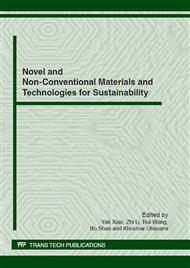p.458
p.469
p.477
p.487
p.495
p.500
p.506
p.513
p.522
Mechanical Strength of Lime-Rice Husk Ash Mortars: A Preliminary Study
Abstract:
Rice is produced in many countries in the world, and this product permits to feed a lot of people, most of them in developing countries. Approximately one tone of rice produces 200 Kg of rice husk, and when this rice husk is burnt 20% of rice husk ash (RHA) is obtained. A very important part of rice husk is abandoned in the field producing environmental problems. RHA can be obtained by controlled combustion, when this fact occurs, a good quality RHA is produced. This RHA can be used as a pozzolanic material in mixtures with lime or Portland cement, producing good mechanical properties and durability. In this work a preliminary results about the influence of RHA/lime ratio on workability and mortars strength was studied. The results showed that mortars workability improves when RHA/lime ratio do. Compressive strength (Cs) of mortars with different RHA/lime ratios was studied, in this sense, for 28 days curing time at 20°C an increase of Cs when RHA/lime ratio do is observed. However for 90 and 180 days curing time a maximum or Cs for RHA/lime equal to 2 is obtained. The lowest and highest Cs values obtained were 6 and 18 MPa respectively, when 20°C curing temperature was used. When curing temperature increases until 65°C similar tendency of Cs respecting RHA/lime ratio was observed. A preliminary study of binders for using in mortars tiles reveals that at least low quantities of Portland cement must be included in binder composition in order to obtain short term strengths that make easy tile demoulding process.
Info:
Periodical:
Pages:
495-499
Citation:
Online since:
June 2012
Authors:
Price:
Сopyright:
© 2012 Trans Tech Publications Ltd. All Rights Reserved
Share:
Citation:


